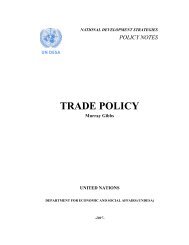16th Meeting of Senior Fellowships Officers of the ... - Development
16th Meeting of Senior Fellowships Officers of the ... - Development
16th Meeting of Senior Fellowships Officers of the ... - Development
Create successful ePaper yourself
Turn your PDF publications into a flip-book with our unique Google optimized e-Paper software.
Administrative Issues 51<br />
170. Ms. Colinet underlined that <strong>the</strong> “in-touch project” was at <strong>the</strong> very beginning <strong>of</strong> <strong>the</strong><br />
planning process. The goals <strong>of</strong> <strong>the</strong> project were to streng<strong>the</strong>n relations between fellows<br />
and <strong>the</strong>ir institutions at home and abroad through a forum which would facilitate<br />
exchange and networking. IAEA also planned to keep former fellows informed on TC<br />
activities and future training opportunities. The project should allow continuous monitoring<br />
<strong>of</strong> quality, impact and possible improvements in <strong>the</strong> fellowships programme<br />
and training courses by tracking <strong>the</strong> career development <strong>of</strong> former fellows by means <strong>of</strong><br />
periodic surveys. It would also <strong>of</strong>fer <strong>the</strong> possibility to update <strong>the</strong> TC database continuously.<br />
Success stories <strong>of</strong> training programmes should be highlighted. Alumni pr<strong>of</strong>iles<br />
should be collected systematically in order to set up a pool <strong>of</strong> experts who could be<br />
selected by field or by region for recruitment. Closely linked to <strong>the</strong> “in-touch” project<br />
was <strong>the</strong> establishment <strong>of</strong> an institutional roster which would respond to <strong>the</strong> request <strong>of</strong><br />
member states to make greater use <strong>of</strong> <strong>the</strong>ir institutional capacities. A roster would enhance<br />
capabilities <strong>of</strong> technical institutions in member states. It would allow sharing information<br />
between and within member states and streng<strong>the</strong>n TCDC. The initial focus<br />
<strong>of</strong> <strong>the</strong> roster would be on institutions in developing countries. The users <strong>of</strong> such a roster<br />
would include, with different rights <strong>of</strong> access, <strong>the</strong> IAEA Secretariat and members states<br />
<strong>of</strong> <strong>the</strong> TC extranet as well as o<strong>the</strong>r users from member states. The next concrete steps<br />
in <strong>the</strong> IAEA projects were: a) cleaning <strong>the</strong> TC databases; b) listing target institutions,<br />
including contacts and statistics by component, and c) establishing <strong>the</strong> IT platform for<br />
storing data as well as ga<strong>the</strong>ring and structuring existing information on <strong>the</strong> capacities<br />
available at <strong>the</strong> regional centres established under regional agreements.<br />
171. Participants voiced <strong>the</strong> importance <strong>of</strong> tracer studies and commended IAEA for <strong>the</strong><br />
great work accomplished. Of general interest was <strong>the</strong> monetary value <strong>of</strong> <strong>the</strong> survey and<br />
<strong>the</strong> human resources involved in <strong>the</strong> process. IAEA spent about 1,000 Euros for <strong>the</strong><br />
s<strong>of</strong>tware ‘Websurveyor’ 21 which was user-friendly and easy to handle. The survey was<br />
conducted by Ms. Colinet and ano<strong>the</strong>r staff member. As for <strong>the</strong> upcoming launching<br />
<strong>of</strong> an institutional roster <strong>the</strong>re would be an inter-regional project on streng<strong>the</strong>ning <strong>the</strong><br />
institutional capacity in developing countries starting in 2007. Hired consultants or<br />
experts from <strong>the</strong> field would update <strong>the</strong> status <strong>of</strong> <strong>the</strong> institutions.<br />
P. Presentation on <strong>Fellowships</strong> Programme Survey, by Ms. Chisato<br />
Aoki, International Tropical Timber Organization (ITTO)<br />
172 Ms. Aoki began her presentation with an overview <strong>of</strong> <strong>the</strong> composition and mandate <strong>of</strong><br />
her organization. She pointed out that ITTO was an intergovernmental organization<br />
established in 1986 by <strong>the</strong> International Tropical Timber Agreement (ITTA) which<br />
was negotiated under <strong>the</strong> auspices <strong>of</strong> <strong>the</strong> United Nations Conference on Trade and<br />
<strong>Development</strong> (UNCTAD). Headquartered in Yokohama, Japan, <strong>the</strong> Organization was<br />
operational since 1986 and had just celebrated its 20th anniversary. It counted 35 staff<br />
members representing 17 countries with one regional <strong>of</strong>ficer in Africa and one in Latin<br />
21 www.websurveyor.com

















